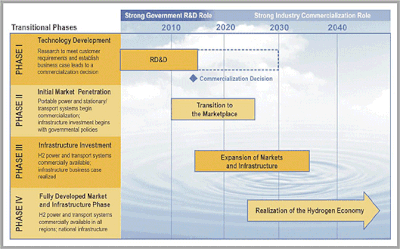
A hydrogen economy is proposed to solve some of the negative effects of using hydrocarbon fuels in transportation, and other end-use applications where the carbon is released to the atmosphere.
In the current hydrocarbon economy, the transportation of people and goods (so-called mobile applications) is fueled primarily by petroleum, refined into gasoline and diesel, and natural gas. However, the burning of these hydrocarbon fuels causes the emission of greenhouse gases and other pollutants. Furthermore, the supply of hydrocarbon resources in the world is limited, and the demand for hydrocarbon fuels is increasing, particularly in China, India and other developing countries.
Hydrogen has a high energy density by weight. The fuel cell is also more efficient than an internal combustion engine . The internal combustion engine is said to be 20–30% efficient, while the fuel cell is 35–45% efficient (some even higher) (not accounting for losses in the actual production of hydrogen, which would result in an overall efficiency of about 25%) and together with the electric motor and controller, the drive train overall efficiency approaches 24% with low idling losses.[6]
Perspective: current hydrogen market (current hydrogen economy)
Hydrogen production is a large and growing industry. Globally, some 50 million metric tons of hydrogen, equal to about 170 million tons of oil equivalent, were produced in 2004. The growth rate is around 10% per year. Within the United States, 2004 production was about 11 million metric tons (MMT), an average power flow of 48 gigawatts. (For comparison, the average electric production in 2003 was some 442 gigawatts.) As of 2005, the economic value of all hydrogen produced worldwide is about $135 billion per year.[7]
There are two primary uses for hydrogen today. About half is used to produce ammonia (NH3) via the Haber process, which is then used directly or indirectly as fertilizer. Because both the world population and the intensive agriculture used to support it are growing, ammonia demand is growing. The other half of current hydrogen production is used to convert heavy petroleumsources into lighter fractions suitable for use as fuels. This latter process is known as hydrocracking. Hydrocracking represents an even larger growth area, since rising oil prices encourage oil companies to extract poorer source material, such as tar sandsand oil shale. The scale economies inherent in large scale oil refining and fertilizer manufacture make possible on-site production and "captive" use. Smaller quantities of "merchant" hydrogen are manufactured and delivered to end users as well.
If energy for hydrogen production were available (from wind, solar or nuclear power), use of the substance for hydrocarbon synfuel production could expand captive use of hydrogen by a factor of 5 to 10. Present U.S. use of hydrogen for hydrocracking is roughly 4 million metric tons per year (4 MMT/yr). It is estimated that 37.7 MMT/yr of hydrogen would be sufficient to convert enough domestic coal to liquid fuels to end U.S. dependence on foreign oil importation,[8] and less than half this figure to end dependence on Middle East oil. Coal liquefaction would present significantly worse emissions of carbon dioxide than does the current system of burning fossil petroleum, but it would eliminate the political and economic vulnerabilities inherent in oil importation.
Currently, global hydrogen production is 48% from natural gas, 30% from oil, and 18% from coal; water electrolysis accounts for only 4%.[9] The distribution of production reflects the effects of thermodynamic constraints on economic choices: of the four methods for obtaining hydrogen, partial combustion of natural gas in a NGCC (natural gas combined cycle) power plant offers the most efficient chemical pathway and the greatest off-take of usable heat energy.
The large market and sharply rising prices in fossil fuels have also stimulated great interest in alternate, cheaper means of hydrogen production.[10]




No comments:
Post a Comment